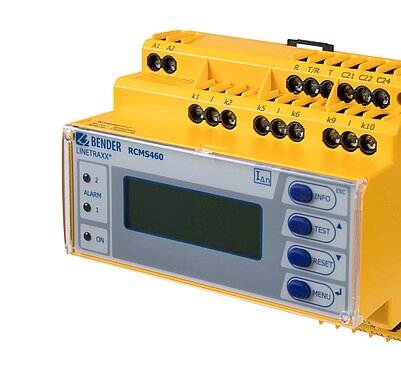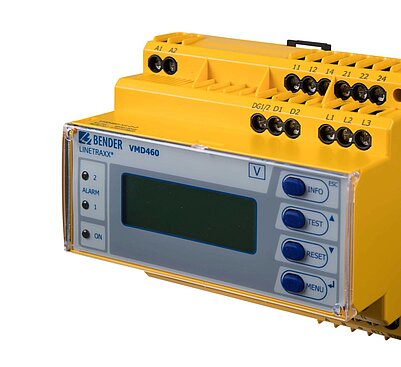

Economic factors dictate the need for high reliability and uptime in power-generating wind turbines. The wind turbines electrical generating system employs a variety of technologies depending on the manufacturer. There are the typical asynchronous machines, where there are often two generators employed in a single turbine. A larger one for higher and a smaller generator each designed to operate at the higher and lower wind speeds. These are usually directly coupled to the grid via a transformer. There are also permanent magnet brushless generators that will indirectly feed the grid via a converter drive. All the electrical systems above are constantly exposed to excessive vibrations, wear and tear, and hazards. Based on their constructive nature, lightning strikes are also a huge problem. Bender mitigates the risk associated with these issues by employing a variety of ground fault detection, insulation monitoring, and fault location units in these demanding environments. Unplanned downtime and time-consuming fault location issues will be reduced to a minimum. Bender’s ground fault protection and insulation monitoring devices continuously monitor wind turbine electrical systems, ensuring early detection of faults and reducing the risk of downtime.
Power for wind turbine controls and operation is usually fed from an external source. The feed to the turbine should be monitored at all times for its electrical integrity since losing the source will render the revenue-producing turbine inoperable until the problem is fixed. Benders ground fault monitoring systems ensure that the supply to the turbine is constantly protected and supervised for electrical breakdown situations.
Alternative energy sources feed-in points must be constantly monitored and switched off in case the main power grid drops off. This practice is known as anti-islanding protection. The Bender VMD460 relay series checks whether the frequency and voltage limits are within range. Additional features such as ROCOF (Rate of change of frequency) and vector jump recognition are added to ensure a proper alert to a missing grid. The three-phase VDM460 relay comes with a preconfigured setting to fulfill the relevant standards such as IEEE1547 but can also be configured via menu by the touch of a button.
Pitch control systems are vital for operating a wind turbine at its maximum peak power output. Electrical faults can render the pit control useless, resulting in the turbine getting stuck at a particular pitch. Worse, it may stall the turbine and drive its output to zero until the problem is fixed. Bender RCMS ground fault monitoring systems constantly record such a system's electrical leakage towards the turbine's chassis. Once the preset thresholds have been breached, the system alerts the personnel as to the problem's level and exact location. With ground fault protection and line isolation monitors in place, wind turbines are safeguarded against electrical failures, maintaining system reliability and uptime.
Azimuth or yaw control systems are gear drive systems designed to direct the wind turbine towards the wind or in very extreme conditions, may even direct the turbine out of the wind. The system usually consists of a wind direction sensing vane coupled to a gear drive and electrical motors. A ground fault in the azimuth control can disable the turbine's “sense of direction” and render it unproductive. Benders RCMA and RCMS ground fault monitoring units will sense an electrical failure at very low levels and alert personnel before the situation worsens. By combining insulation monitoring devices and regular LIMvtesting, Bender products help keep wind turbine systems fully operational and electrically safe, preventing unexpected failures.
Bender's COMTRAXX gateways communicate the insulation and ground fault values from the wind power plant via Ethernet/TCP-IP or Modbus to the higher-level supervisory systems or the operators for a clear concise picture of the overall electrical health of the turbine. Bender’s line isolation monitors, along with LIM testing, provide an added layer of electrical safety, helping to identify and isolate potential issues in wind turbine control systems.
| Name | Category | Size | Language | Timestamp | D-/B-Number |
|---|---|---|---|---|---|
| Product Overview ISOMETER®/ISOSCAN® | Product Overviews | 5.3 MB | EN | 2024/02/1616.02.2024 | |
| Renewable Energies | Market Segment Brochures | 3.6 MB | EN | 2025/04/0303.04.2025 | |
| Safe Connection to the Grid VMD460-NA | Flyers | 222.0 KB | EN | 2019/05/1313.05.2019 | D00001 |
| Answers for Tomorrow | Technical Article | 764.8 KB | EN | 2019/05/1313.05.2019 | |
| Bender Industry Applications | Market Segment Brochures | 5.9 MB | EN | 2024/09/0404.09.2024 |
Products

Ground-fault detector for ungrounded AC/DC systems

Ground-fault location module for ungrounded AC/DC systems

Portable ground-fault location systems for ungrounded and grounded systems

Multi-channel AC/DC ground-fault monitor

Multi-channel AC/DC ground-fault monitor with individual relay outputs

Network and system protection (NS protection) for monitoring the power infeed of power generation systems
![[Translate to North American English:] COMTRAXX® COM465IP](/fileadmin/_processed_/f/d/csm_COM465IP_01_WEB_296d1e7f5c.jpg)
Condition Monitor with an integrated gateway for the connection of Bender devices to Ethernet-TCP/IP networks

Ground-fault detector for ungrounded AC/DC systems

Ground-fault location module for ungrounded AC/DC systems

Portable ground-fault location systems for ungrounded and grounded systems

Multi-channel AC/DC ground-fault monitor

Multi-channel AC/DC ground-fault monitor with individual relay outputs

Network and system protection (NS protection) for monitoring the power infeed of power generation systems
![[Translate to North American English:] COMTRAXX® COM465IP](/fileadmin/_processed_/f/d/csm_COM465IP_01_WEB_296d1e7f5c.jpg)
Condition Monitor with an integrated gateway for the connection of Bender devices to Ethernet-TCP/IP networks
Windenergieanlagen - Teil 2: Anforderungen für kleine Windenergieanlagen
Messrelais und Schutzeinrichtungen - Teil 127: Funktionsnorm für Über-/Unterspannungsschutz
Ausrüstung von Starkstromanlagen mit elektronischen Betriebsmitteln